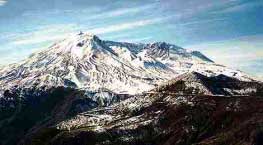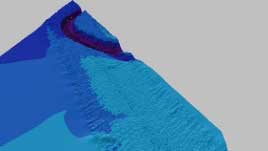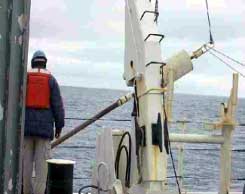 |
||||||||||
| Home » Program » Voyages » Summer 2004 | ||||||||||
The Sea Scholars Voyage 2004Journal Entries: Thursday, October 18, 2004 - Pat Burke and Staci Pierce
A lifeboat drill capped the day at 1520 hours. This included gathering your PFD (personal flotation device) and moving to the weather deck. The Chief Mate, Chris Kali, directed our drill. We learned how to launch the life boats and deploy the life rafts. Each raft or boat has food, water and other necessities to sustain life until rescued. Today the seas were three to four feet, weather was clear and warm and the food was excellent! See you from the fantail tomorrow…
Aloha from USNS Sumner… Friday, October 19, 2004 - Sarah Mitchell and Margaret Clark With several days behind us now, everyone seems to be adapting to their new sea legs. The cooks continue to amaze us with their wonderful meals, the captain continues to keep us on course and the deck hands all help keep the ship “ship shape”.
Our classes continued today, with one of the highlights being meteorology. This was taught by our two accompanying Naval crew, AGCS Potts and AG2 Brown. After a brief lesson on weather patterns and layers of atmosphere, including thunder storms and Our balloon immediately started sending back data and continued to do so to a height of 57,000 feet. The hardest part was getting the filled balloon out of the wet lab without touching anything.
Another activity was a plankton tow. The ship was slowed down from 14 to 2 knots to allow a plankton net to be towed behind the ship. This was thrown overboard and towed for 15 minutes.
Signing off south of latitude 30 degrees. Looking forward to another great day tomorrow and always calm seas!!
Today was an interesting break from classes. We spent the morning and a good part of the afternoon presenting some of our favorite labs, activities, lessons, and resources to each other. The giving spirit was in abundance. After lunch the ship was slowed to 2 knots in order to conduct several activities. First we put the plankton tow back into the water to collect another sample. While the plankton net was sampling, we launched a 600 g weather balloon. This was larger than the balloon that each group previously deployed. We managed to keep it under a tarp to get it filled up and ready for release. We tracked the balloon all the way to 59,819 ft. Remember, with your weather balloon the key is to “LET IT GO!” The seas continue to be a little rough at night, but other than that it is smooth sailing! Aloha from the USNS Sumner. Thursday, October 21, 2004 - Doug Blanchard and Anne Holbrook
Who navigates the USNS Sumner? Several people can fulfill this role:
Gerard grew up in Los Angles, CA and recently bought a house there-near water but not on it. He was previously a sailor in the Navy, then attended the California Maritime Academy, and later the AMO Star Center. He plans to move up to Second Mate after this voyage-he needed a year of sea time and passing grades on his coast guard tests. He likes to fix up his house and travel on land during his vacation time.
Captain Fred Smallwood from Gulfport, MS. He is a retired Naval officer that couldn't get enough of the sea. He enjoys his job and likes the flexibility of it. He has his own chair on the bridge. Once there was a new able seaman on his first voyage on a ship. He saw the chair on the bridge and decided to take a brief rest in the only chair on the bridge. The captain came onto the bridge and saw the seamen in his chair. He told the seaman that only two people are permitted in the bridge chair-the captain and the unemployed. The seaman was put ashore, he did not travel on his first ship, but he never sat in the Captain's chair again. The position for today is: 38.11N 136.34W The wind was 15 knots--a little bouncy for teachers! No stops for activities. Friday, October 22, 2004 - Anne Holbrook Words: Filled the front bow ballast with water to have less pitch to the ship. Saturday, October 23, 2004 - Jennifer Hyche and Anne Holbrook During our voyage in the northern Pacific Ocean, we had the opportunity to get a glimpse of two landforms under the sea. First, we observed the Multibeam images on the console in the ship's Survey Lab, which appeared to be a seamount in the making. Compare the seamount with a mountain. How are they similar? Different? The seamount was located at approximately 43-30N and 128-55W.
Another landform is our river channel located along the seabed under approximately 3500-m of water. The channel itself measures approximately 150-m deep and 3 km wide. (1.5 miles) What is the possible source of the river channel? Could it be the river flow off the continent? What does this imply about sediment transfer throughout the oceans? What may this tell you about historic sea levels of the Pacific Ocean? Compare the river channel located at approximately 43-32N and 128-50W to the river in Bangladesh.
The ocean is an important resource for oil—energy! How can we find it? How does drilling for oil and drilling for historic information aid us in learning more about the ocean? Knowledge of oceanic features such as hydrothermal vents, aid scientists in determining potential locations of viable economic resources---oil. By drilling through layers of sediment and rock, geologists can interpret climate history dating thousands to millions of years. Additionally, scientists can learn about historical positions of the continents and the ocean basins.
The voyage is coming to an end but this is just a beginning for understanding our vast frontier—our Planet Earth's ocean environment. Position: 42-00N 131-17W
|
| This site was made possible by a grant from the National Oceanographic Partnership Program and was developed in partnership with the Naval Oceanographic Office. |
|
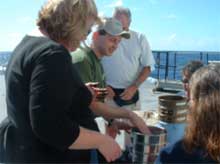 Today we began our Oceanography sessions. Each group had two courses to attend. The courses available were Acoustics, Bathymetry, Geology, Biological Oceanography Physical Oceanography, and Meteorology. In the geology session led by Rich Balser, the shipek grab sediments were sorted by grain size using different sized sieves and compared to last years Tortuga's samples. Sediment types such as sand, silt or clay were also determined, as well color of sediments. Siliceous radiolarians were mostly found due to the depth and cold temperature of the water.
Today we began our Oceanography sessions. Each group had two courses to attend. The courses available were Acoustics, Bathymetry, Geology, Biological Oceanography Physical Oceanography, and Meteorology. In the geology session led by Rich Balser, the shipek grab sediments were sorted by grain size using different sized sieves and compared to last years Tortuga's samples. Sediment types such as sand, silt or clay were also determined, as well color of sediments. Siliceous radiolarians were mostly found due to the depth and cold temperature of the water.  Dr. Shelia Brown led the session on Biological Oceanography. Issues discussed were different ocean zones including the intertidal zone, neritic zone, oceanic zone and the benthic zone. Lifestyles of these organisms living in these zones are plankton, nekton, and benthos.
Dr. Shelia Brown led the session on Biological Oceanography. Issues discussed were different ocean zones including the intertidal zone, neritic zone, oceanic zone and the benthic zone. Lifestyles of these organisms living in these zones are plankton, nekton, and benthos. 
 Speaking of our ship, we wanted to include some information about our accommodations. Each room is shared by two participants and our bath is shared by two rooms.
Speaking of our ship, we wanted to include some information about our accommodations. Each room is shared by two participants and our bath is shared by two rooms.  We eat all our meals in the officers' dining room and the food is fabulous. Getting to know the entire crew is fun and we receive wonderful hospitality.
We eat all our meals in the officers' dining room and the food is fabulous. Getting to know the entire crew is fun and we receive wonderful hospitality. 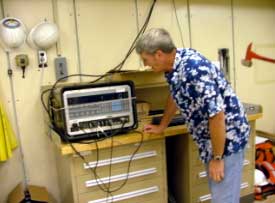 hurricanes, we were given a chance to plot surface weather observations the old fashioned way. Senior Jeff Potts said that this is a dying art because today this plotting is almost exclusively done by computers. Before launching our weather balloon, we took a trip to the bridge to collect surface data. This included temperature, wind speed and direction, and humidity. then it was off to launch the weather balloon. AG2 Brown explained the attached recording devices and the lab computers which are used to record our data. Next she showed us how to fill the balloon and how to correctly launch it.
hurricanes, we were given a chance to plot surface weather observations the old fashioned way. Senior Jeff Potts said that this is a dying art because today this plotting is almost exclusively done by computers. Before launching our weather balloon, we took a trip to the bridge to collect surface data. This included temperature, wind speed and direction, and humidity. then it was off to launch the weather balloon. AG2 Brown explained the attached recording devices and the lab computers which are used to record our data. Next she showed us how to fill the balloon and how to correctly launch it. 
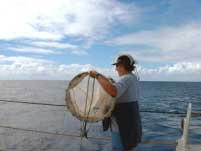

 Wednesday, October 20, 2004 - John Moore and Connolly Coyle
Wednesday, October 20, 2004 - John Moore and Connolly Coyle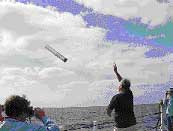 As a group, we also completed an acoustics experiment. Two sonobuoys, which record underwater sounds, were released from the fantail.
As a group, we also completed an acoustics experiment. Two sonobuoys, which record underwater sounds, were released from the fantail. After a short waiting period, we dropped light bulbs attached to a 1 lb. weight. The bulbs implode when they reach approximately 1000 feet. The sound of the implosion was easily heard and recorded by Jay's computer that was receiving transmission from the sonobouy even though the bulbs were far behind by then. After listening to the bulb we pulled in the plankton tow and were pleased to find a rich sample of organisms.
After a short waiting period, we dropped light bulbs attached to a 1 lb. weight. The bulbs implode when they reach approximately 1000 feet. The sound of the implosion was easily heard and recorded by Jay's computer that was receiving transmission from the sonobouy even though the bulbs were far behind by then. After listening to the bulb we pulled in the plankton tow and were pleased to find a rich sample of organisms. This seaman must do bridge watch and gangway watch as well. He is on the fire fighting team too. He was born in Ghana and now lives in New Orleans, LA. He graduated from Tad's High school and later Kikam Tech. His title and name is: Able Seaman Samuel Akuffo. The watch does just that-observes the area around the ship-360 degrees. The ship maintains a safe navigational distance of one mile, port and starboard (on the left and right sides) of the ship and two miles fore and aft (in front of and behind) the ship. On a previous voyage, the Third Mate and Sammy observed an overturned fishing boat in the North Atlantic during their watch. Immediately they searched for survivors. They found two and returned them to shore. They came upon this situation by chance and not because the fishing boat sent out a signal of distress. These were two lucky sailors!
This seaman must do bridge watch and gangway watch as well. He is on the fire fighting team too. He was born in Ghana and now lives in New Orleans, LA. He graduated from Tad's High school and later Kikam Tech. His title and name is: Able Seaman Samuel Akuffo. The watch does just that-observes the area around the ship-360 degrees. The ship maintains a safe navigational distance of one mile, port and starboard (on the left and right sides) of the ship and two miles fore and aft (in front of and behind) the ship. On a previous voyage, the Third Mate and Sammy observed an overturned fishing boat in the North Atlantic during their watch. Immediately they searched for survivors. They found two and returned them to shore. They came upon this situation by chance and not because the fishing boat sent out a signal of distress. These were two lucky sailors! Our navigator and safety person is 3rd Mate Gerard Washington this morning. Navigation involves: planning the voyage, determining the ship's position, radar plotting, look out and ship handling. There are times when navigating is more difficult than others are. Pusan, Korea has many small boats that people live on and the ship must navigate around these floating neighborhoods. Gerard also recalls navigating the Mississippi River with its moving boats and vessels. In this case, he must keep in mind the Rules of the Road-like the rules for driving a car. He must follow the Rules of the Water, the Standard Operating Protocol (Captain's rules that each crewmember signs before leaving port) and the survey request (the specific course that must be followed).
Our navigator and safety person is 3rd Mate Gerard Washington this morning. Navigation involves: planning the voyage, determining the ship's position, radar plotting, look out and ship handling. There are times when navigating is more difficult than others are. Pusan, Korea has many small boats that people live on and the ship must navigate around these floating neighborhoods. Gerard also recalls navigating the Mississippi River with its moving boats and vessels. In this case, he must keep in mind the Rules of the Road-like the rules for driving a car. He must follow the Rules of the Water, the Standard Operating Protocol (Captain's rules that each crewmember signs before leaving port) and the survey request (the specific course that must be followed). Who is responsible for everyone and everything that happens on the USNS Sumner?
Who is responsible for everyone and everything that happens on the USNS Sumner?
